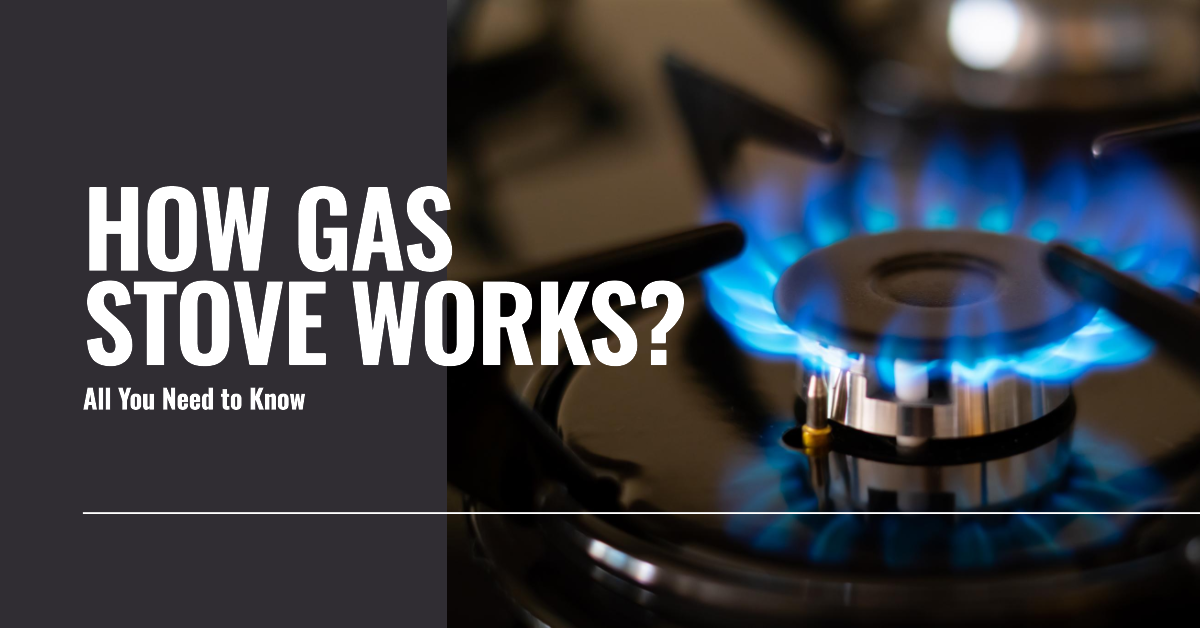Gas stoves have been a staple in kitchens around the world for decades. They offer quick and precise heating, making cooking a breeze. But have you ever wondered how gas stoves work and why they are so efficient?
In this comprehensive blog post, we will take you on a journey through the inner workings of a gas stove, from the ignition to the final flame.
By the end, you’ll have a deep understanding of how gas stoves operate and why they remain a popular choice for cooking enthusiasts.
Learn Everything About How Gas Stoves Work: A Step-by-Step Guide
To understand how gas stoves work, let’s start with their basics:
a. The Basics of Gas Stoves:
Before we delve into the mechanics of gas stoves, let’s start with the basics. Gas stoves rely on natural gas or propane as their fuel source. These gases are highly combustible, and when ignited, they produce a controlled flame that generates heat. The heat is then used to cook food placed on the stove’s burners.
Natural gas is the most common fuel for residential gas stoves. It is a mixture of hydrocarbons, primarily composed of methane, which is odorless. To detect gas leaks easily, a chemical called mercaptan, which produces a distinct smell, is added to natural gas.
Propane, on the other hand, is often used in areas where natural gas is not readily available. It is a liquefied petroleum gas (LPG) that is stored in pressurized tanks. Propane is commonly used in outdoor grills and portable stoves due to its portability and high energy content.
b. Ignition Process:
The ignition process is the first step in how gas stoves work. Modern gas stoves typically use electronic ignition systems that create a spark to ignite the gas. When you turn the knob on the stove, the electronic igniter sends a spark to the gas coming out of the burner. This spark ignites the gas, producing a flame.
Older gas stoves used a pilot light for ignition. A small, continuously burning flame was located near the burner. When you turned the stove knob, the gas flow would be directed towards the pilot light, and it would ignite the main burner when the gas reached it. However, electronic ignition systems are more efficient and safer, as they eliminate the need for a constant pilot flame.
c. Gas Flow and Regulation:
To control the intensity of the flame, gas stoves are equipped with gas flow regulators. These regulators adjust the amount of gas flowing to the burner, determining the size and heat intensity of the flame. Turning the stove knob up increases the gas flow, resulting in a larger flame, while turning it down decreases the flow, producing a smaller flame.
Modern gas stoves often feature knobs with precise temperature markings, allowing users to set specific heat levels. This precise control over the flame makes gas stoves ideal for delicate cooking tasks, such as simmering and sautéing.
d. Burner Design:
Gas stove burners are engineered for efficiency and even heat distribution. The burner consists of small holes or slots through which the gas is released. These holes are strategically placed to create an even flame that covers the entire bottom of the pot or pan, ensuring uniform cooking.
Some gas stoves have specialized burners designed for specific cooking tasks. For example, some models have a power burner with a higher heat output for rapid boiling, while others have a simmer burner for gentle heat suitable for delicate sauces and reductions.
In recent years, manufacturers have introduced advanced burner designs, such as sealed burners and continuous grates, which not only improve heat distribution but also make cleaning and maintenance easier.
e. Combustion and Heat Transfer:
When the gas ignites, it undergoes combustion, a chemical process where it reacts with oxygen to produce heat. The flame heats the bottom of the cookware, and this heat is then transferred to the food inside the pot or pan. Gas stoves offer quick heat-up times and precise temperature control, making them ideal for various cooking techniques.
The blue part of the gas flame indicates complete combustion, where the gas is burning efficiently with sufficient oxygen. The outer, yellow part of the flame results from incomplete combustion due to insufficient oxygen. It is essential to adjust the air-to-fuel ratio correctly to achieve a blue flame, as it ensures efficient burning and minimizes the production of harmful byproducts, such as carbon monoxide.
The Efficiency of Gas Stoves: Top Five Facts
a. Energy Efficiency:
Gas stoves are known for their energy efficiency compared to electric stoves. Unlike electric stoves, which lose energy due to heat transfer through the stovetop, gas stoves transfer heat directly to the cookware. This direct heat transfer minimizes heat loss and results in faster cooking times.
Additionally, gas stoves provide instant heat. When you turn the knob, the flame adjusts immediately, providing quick response times to changes in heat settings. This responsiveness allows for precise cooking and minimizes wasted energy.
b. Quick Heat-Up and Cool-Down:
Gas stoves offer quick heat-up times and cool-down periods. When you turn the knob, the flame adjusts instantly, providing immediate control over the cooking process. This quick response allows for efficient cooking and reduces the risk of overcooking or burning food.
Moreover, when you turn off a gas stove, the heat dissipates quickly, allowing the stovetop to cool down rapidly. This feature is especially beneficial when you need to stop cooking suddenly or when you want to avoid residual heat affecting the food.
c. Precise Temperature Control:
One of the significant advantages of gas stoves is their precise temperature control. The ability to adjust the flame allows for a wide range of heat levels, making gas stoves ideal for various cooking techniques. Whether you need a gentle simmer for sauces or a high-temperature sear for meats, a gas stove offers the flexibility to accommodate all cooking needs.
The immediate response to changes in heat settings allows for precise adjustments in real-time, giving cooks greater control over their culinary creations.
d. Reliability and Responsiveness:
Gas stoves are highly reliable and functional even during power outages. Since they do not depend on electricity for operation, you can continue cooking even when the power goes out. This feature is particularly beneficial in areas with unreliable power supply or during emergencies.
The responsiveness of gas stoves to heat adjustments adds to their reliability and convenience in the kitchen. Whether you’re reducing the heat to a simmer or turning it up for a rapid boil, the flame responds instantly to your commands, ensuring consistent cooking results.
e. Safety Features:
Modern gas stoves are equipped with various safety features to prevent gas leaks and accidents. Automatic shut-off valves are installed to stop the gas flow if the flame is extinguished accidentally. Additionally, some models have sensors that detect gas leaks and trigger alarms or shut down the gas supply, ensuring safety in the kitchen.
It is essential to follow proper safety practices when using a gas stove. Always ensure proper ventilation in the kitchen to prevent the accumulation of gas fumes. Regularly inspect gas lines and connections for any signs of damage or leaks, and never leave a gas stove unattended while cooking.
Final Words
Gas stoves have been a culinary companion for many households, offering efficient and reliable cooking capabilities. In this blog post, we’ve uncovered the inner workings of gas stoves, from the ignition process to energy efficiency and safety features.
Understanding how gas stoves work will not only enhance your cooking experience but also give you the confidence to cook with precision and care. So the next time you fire up your gas stove to create a delicious meal, you’ll appreciate the science behind its efficient operation.
Whether you’re a seasoned cook or just starting in the kitchen, a gas stove’s reliability and versatility make it a top choice for culinary enthusiasts worldwide.

